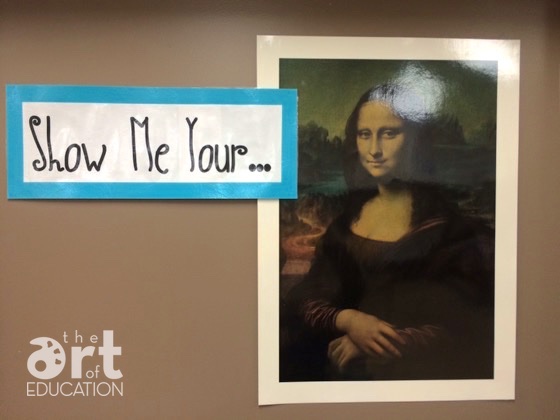
Art class can be a messy whirlwind of chaos if expectations and routines aren’t established or consistent. Routines provide sanity and safety for both the teacher and the students. When students know what is expected of them, there’s less room for confusion, and in turn, less room for misbehavior.
Below are eight essential routines that will get your art room to function like a well-oiled machine.
1. Enter the art room in a consistent, quiet manner.
This can work week-to-week or day-to-day. I use a visual prompt at my door each day for students to read as they enter.
2. Try, “3-2-1; show me the Mona Lisa.”
This is an awesome attention-getter I learned in the Managing the Art Room course! Students know to imitate the Mona Lisa when I call for attention. This happens to work for my Kindergarten through sixth-grade students. Here are some other great attention-getters! Whether it’s verbal or not, the idea is to keep it consistent so that students know how to behave when the prompt is given.
3. Provide clear and concise communication.
This is specifically for demonstrations, general directions, and directions for transitions. I aim to only share essential information with my students while giving directions of any sort. This way, I don’t over-burden them or lose attention as I drone on. My daily directions may change, but the routine for students to transition to their seats remains the same.
4. Give attention to students who raise their hands patiently.
Two of my biggest headaches occur when students shout my name over and over or follow me around like a row of ducklings. I am clear that I help those who raise their hands and wait patiently. This is the trickiest routine for me! Students are so eager and excited that sometimes even I forget and give in to their blurting.
5. Manage materials.
I have designated jobs for distributing, maintaining, organizing, and counting materials. Locations and spaces are clearly labeled for students to access materials autonomously. It may seem tedious, but at the end of each class, we count our supply baskets. We make sure the same number of materials are in the baskets that were there in the beginning. This step ensures that future classes have enough materials. It also ensures that I don’t waste the art budget on the same materials over and over.

6. Finish work early.
Within the first few weeks of school, I share the activities available to students when, or if, they finish a project early. These include how-to-draw books, the art room library, or other art-related games and activities. They know to pick one of these activities without distracting others.
7. Clean up.
Using the jobs mentioned in #5, this streamlined approach to clean-up transformed what could become a chaotic time in my art room.

8. Line up to leave.
After clean-up, students are left in their seats with nothing but their sketchbooks and their body basics at the end of class. Tables are chosen based on their speed of clean-up and their silent readiness to line up. We leave the art room when the line is quiet and ready to enter the hallway using our school-wide hallway basics.
I have adapted these routines to work for me from year to year and even class to class. It’s important to find routines and expectations that you are comfortable with and can carry out with fidelity. I keep a short list of resources and strategies if I find a routine has become ineffective. My favorite classroom management guru, Michael Linsin, has multiple books on this subject. He encourages us to seek and employ routines that “model every repeatable moment of your day.” Always explain your expectations in detail. Model, practice, and reteach if necessary.
If you’re looking for even more management tips, check out 5 Steps You Can Take Now to Reduce Management Issues Later!
What are your fundamental routines? Do you have one of which you’re the proudest?
What is the one routine you couldn’t live without?
Magazine articles and podcasts are opinions of professional education contributors and do not necessarily represent the position of the Art of Education University (AOEU) or its academic offerings. Contributors use terms in the way they are most often talked about in the scope of their educational experiences.





